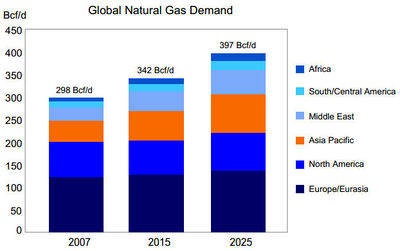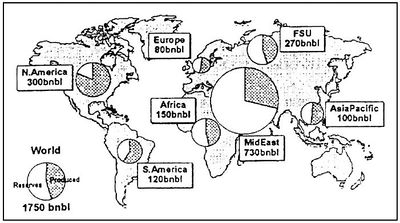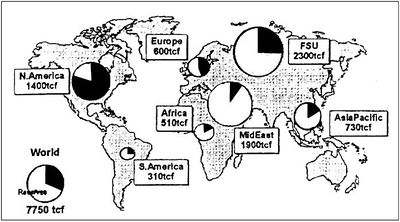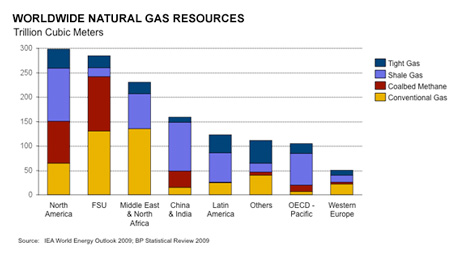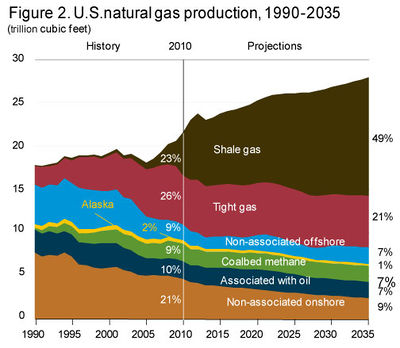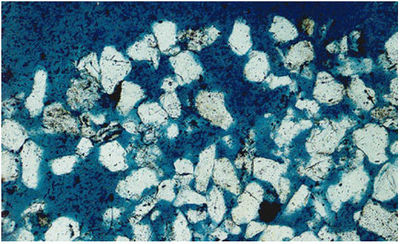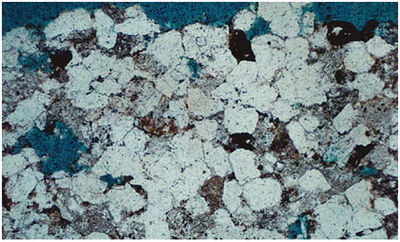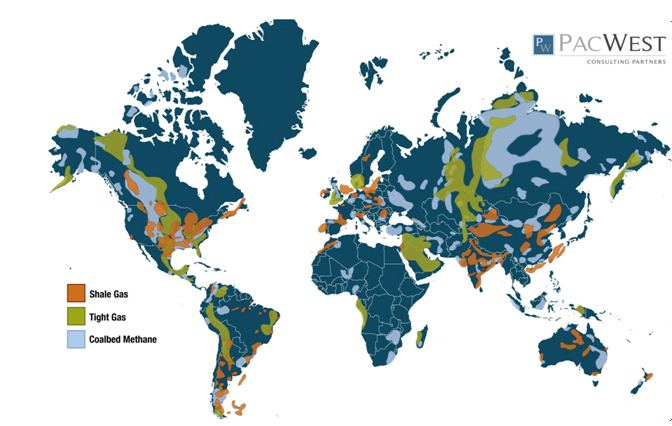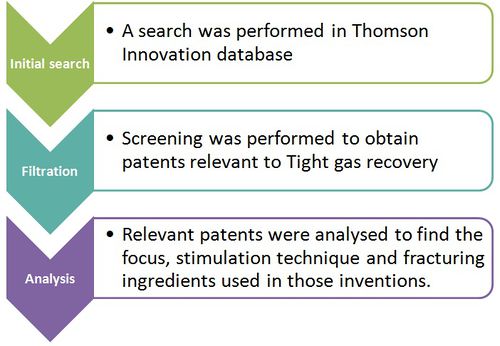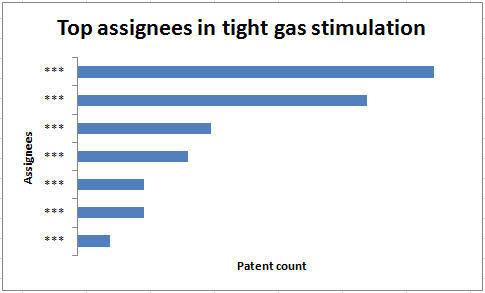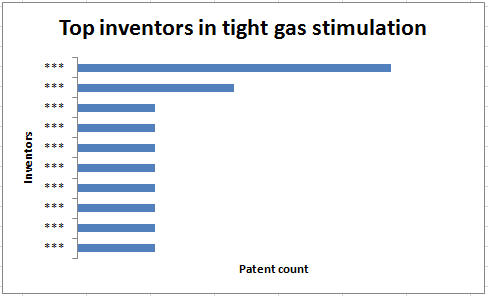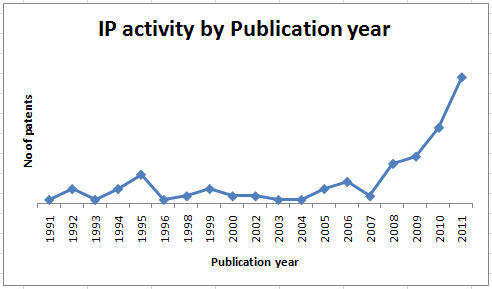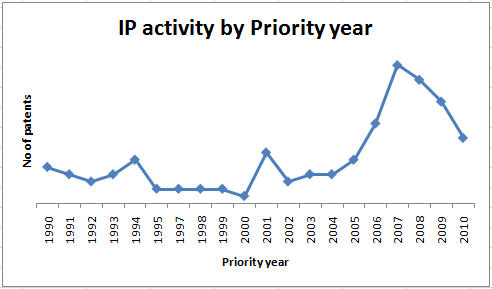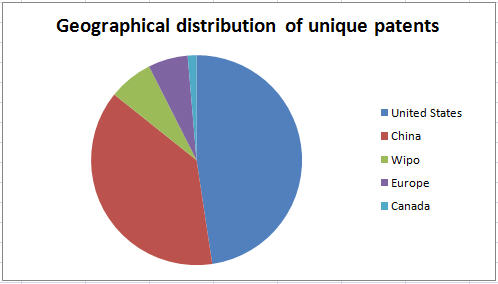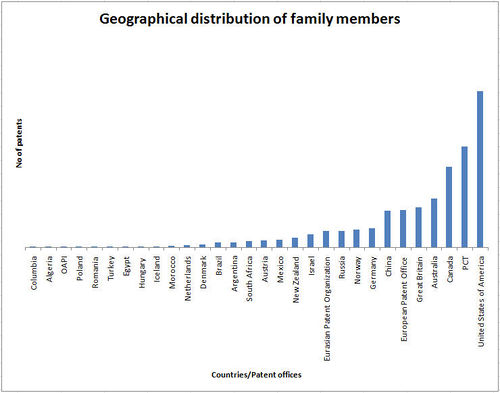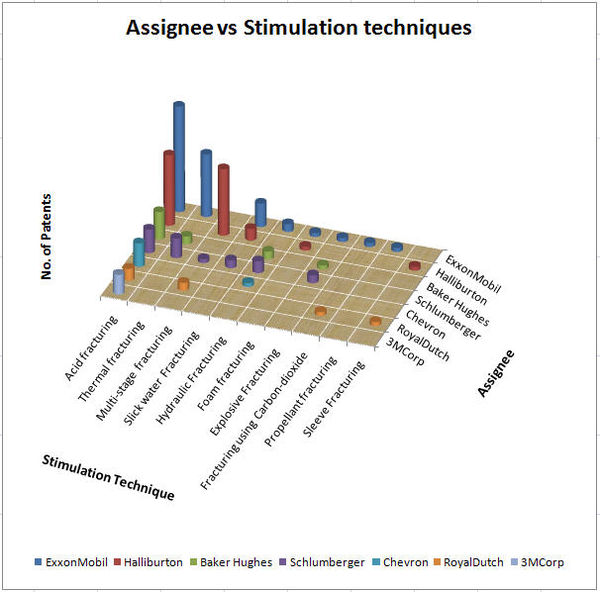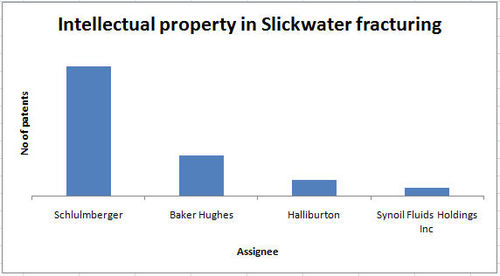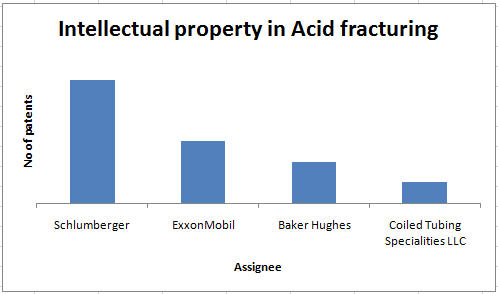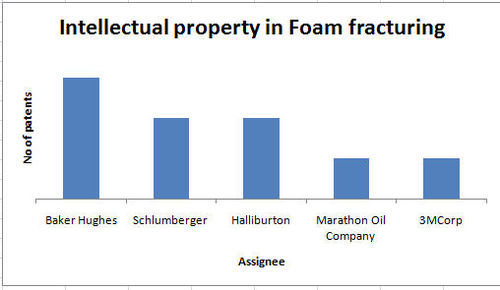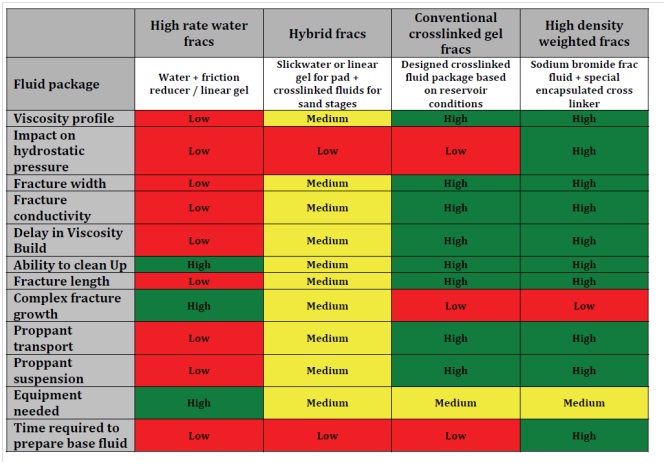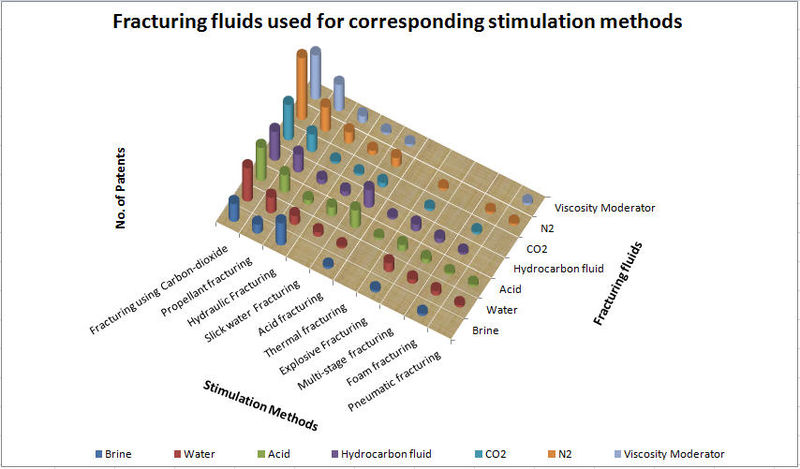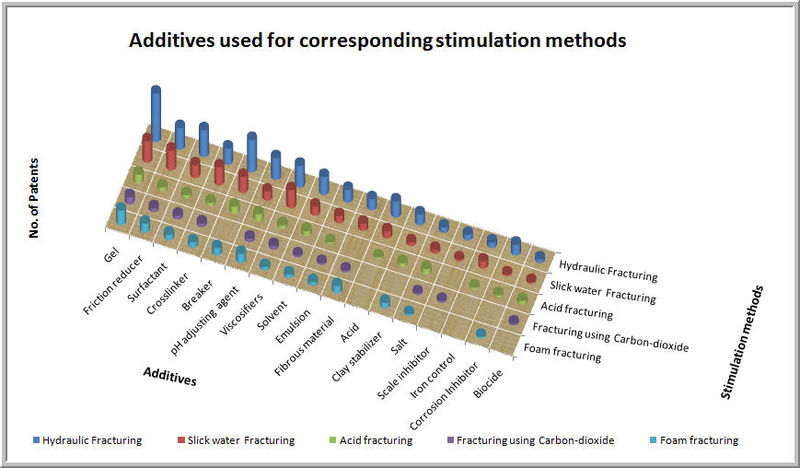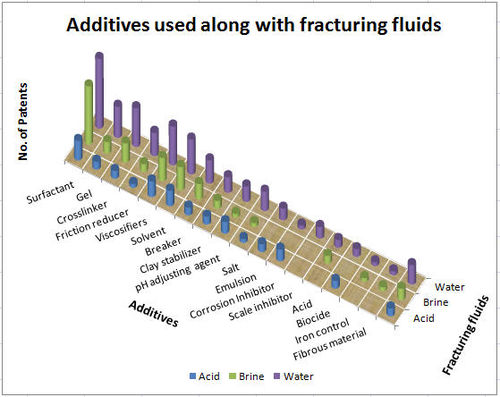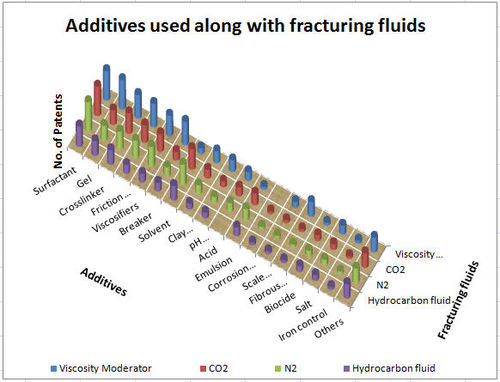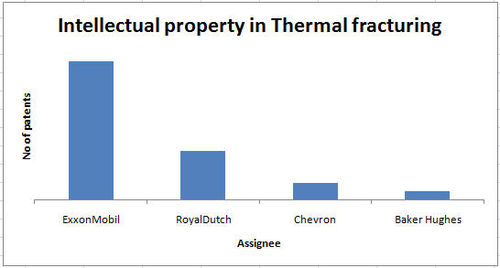Tight Gas Fracturing Technology and Patent Report
Contents
- 1 Background
- 1.1 Introduction
- 1.2 Tight Gas
- 1.2.1 Conventional and Unconventional Reservoirs
- 1.2.2 Properties of Tight Gas
- 1.2.3 Map of unconventional reserves (Shale,Tight,Coalbed methane) in the world
- 1.2.4 Distribution of Tight Gas across the world
- 1.2.5 Recovery of Tight Gas
- 1.2.6 Challenges for Tight Gas Recovery
- 1.2.7 Taxonomy for various technical challenges in tight gas recovery
- 2 Methodology for Patent Search
- 3 Taxonomy for patent analysis for tight gas recovery
- 4 Stimulation Techniques
- 4.1 Graphical representation of Assignee vs Stimulation techniques
- 4.2 Hydraulic Fracturing
- 4.3 Multi Stage Fracturing
- 4.4 Slickwater Fracturing
- 4.5 Acid Fracturing
- 4.6 Carbon dioxide Fracturing
- 4.7 Foam Fracturing
- 4.8 Explosive Fracturing
- 4.9 Sleeve fracturing
- 4.10 Hydrocarbon recovery by using biogenic materials combined with Pneumatic fracturing
- 4.11 Chemical reaction induced pressure pulses fracturing
- 4.12 Propellant Fracturing
- 4.13 High pressure & high temperature (HPHT) fracturing
- 5 Fracturing Fluids and Additives used
- 5.1 Graphical representation of Fracturing fluids used for corresponding stimulation methods
- 5.2 Proppant
- 5.3 Acid
- 5.4 Biocides
- 5.5 Breaker
- 5.6 Corrosion inhibitor
- 5.7 Crosslinker
- 5.8 Friction Reducers
- 5.9 Gel
- 5.10 Viscosifiers
- 5.11 Clay stabilizer
- 5.12 Surfactant
- 5.13 Iron control
- 5.14 pH adjusting agent
- 5.15 Scale inhibitor
- 5.16 Fibrous material
- 5.17 Solvents
- 5.18 Salts
- 5.19 Emulsions
- 5.20 Miscellaneous compounds
- 5.21 Trade names additives used for fracturing fluids
- 6 Heat Treatment
- 7 Challenges in Tight Gas
- 8 Appendix
- 9 References
Background
Introduction
Global demand for natural gas is increasing day by day as due to rapidly growing gas market of developing countries. As more nations are switching to environmentally cleaner fuels to maintain the economic growth and reducing the impact of increasing high oil price. Natural gas is emerged as an excellent environmentally clean fuel as it emits 43% fewer carbon emissions the coal and 30% fewer emissions than oil for each energy delivered. In order to fulfill the increasing demand of energy requirement and reducing greenhouse gas emission. “The quickest and cheapest way to cut CO2 emissions from the global power sector is to grow the presence of natural gas,” said Shell’s exploration Chief Malcolm Brinded in a speech late last year. Shell-Malcolm Brinded
Global Natural Gas Demand
According to the U.S. Energy Information Agency (EIA) latest report the global demand for natural gas is expected to grow significantly as more nations are switching to environmentally cleaner fuels such as Natural Gas. Majority of the rapidly growing gas markets are in emerging economies in Asia, particularly India and China, the Middle East and South America. EIA also shows worldwide natural gas demand grew by 57 Bcf/d from 2000 to 2007, nearly 25%. The EIA also projects global natural gas demand to grow over 40 Bcf/d by the year 2015, and projects a further growth in demand of over 50 Bcf/d by 2025.
Outlook for LNG.pdf EIA-Report
Current Scenario
Bentley R. W., 2002 of The Oil Depletion Analysis Centre London studied on Global oil & gas depletion: An overview. It shows that the world’s production of conventional hydrocarbons will soon decline. Global conventional oil supply is currently at political and physical risk. This is because the sum of conventional oil production from all countries in the world, except the five main Middle-East suppliers, is near the maximum set by physical resource limits. A large investment in Middle-East oil production is needed to overcome this physical risk, and to fulfill the increasing demand of hydrocarbon across the globe. Figure 2 Shows the global conventional oil distribution of the world’s, conventional oil that has been consumed (dark shading), and the currently discovered reserves (light colour). The figure uses industry (proved and probable) data for reserves (not public domain ’proved’ reserves), and excludes oil yet to- find. The major concluding points from this figure shows the world is about halfway through its effective recoverable resource base and North America has burnt about three-quarters of its recoverable conventional oil resource.
For conventional gas, since less gas has been used so far compared to oil, the world will increases its dependability to gas as oil declines. Figure 3 Shows the global conventional gas distribution of the world’s, conventional gas that has been consumed (dark shading), and the currently discovered reserves (light colour). The figure uses industry (proved and probable) data for reserves (not public domain ’proved’ reserves), and excludes oil yet to- find. The major concluding points are Europe has a little way to go before its gas peak, and the world as a whole is about halfway to its gas peak. When the ’clocks’ on this figure tick round to perhaps 8 or 9 o’clock, gas decline sets in with the decline likely to be fairly steep.
Present scenario shows that with the physical resource limits and depletion of oil there is exponential increase the demand of gas. The global peak in all hydrocarbons (oil plus gas) is likely to be in about 10 or so years. Thus there is do or die situation for development of unconventional reservoir across the globe for avoiding the situation of energy crisis in the world. http://greatchange.org/ov-bentley,global_depletion.pdf Global Depletion-Bentley
Natural Gas Distribution
Worldwide Natural gas resources shows North America contain the largest reserves of 300 Trillion cubic meters in which unconventional resources is around 230 Trillion cubic meters. Former Soviet country shows second largest reserves of 270 Trillion cubic meters in which unconventional resources is around 140 Trillion cubic meters. China and India also contain the reserves of 160 Trillion cubic meters in which unconventional resources is around 145 Trillion cubic meters. African countries, Latin America, Western Europe and others show the presence of Unconventional resources.
Worldwide Natural gas resources
U.S. Energy Information Administration’s preview of its 2012 Annual Energy Outlook is the forecast for natural gas. EIA says that gas from shale and tight gas will account for 70 percent of the United States’ overall natural gas supply in 2035. It is clearly visible from the Figure 5 that there’s been a surge in shale gas production since roughly 2005. The major reason for this surge in shale gas production is due to surge in new hydraulic fracturing and horizontal drilling techniques, which helps in unlocking vast shale gas formations in states including Pennsylvania, North Dakota and Texas. And similar development is dawning in Ohio and other states too of North America.EIA-Shale report
Tight Gas
- Tight gas refers to natural gas reservoirs locked in extraordinarily impermeable, hard rock, making the underground formation extremely "tight." Tight gas can also be trapped in sandstone or limestone formations that are typically impermeable or nonporous, also known as tight sand. In other words, the pores in the rock formation in which the gas is trapped are either irregularly distributed or badly connected with overly narrow capillaries, lessening permeability or the ability of the gas to travel through the rock. Without secondary production methods, gas from a tight formation would flow at very slow rates, making production uneconomical.
- While conventional gas formations tend to be found in the younger Tertiary basins, tight gas formations are much older. Deposited some 248 million years ago, tight gas formations are typically found in Paleozoic formations. Over time, the rock formations have been compacted and have undergone cementation and recrystallisation, which all reduce the level of permeability in the rock. Tight gas-Rigzone.
Conventional and Unconventional Reservoirs
Conventional reservoirs are those that can be produced at economic flow rates and that will produce economic volumes of oil and gas without large stimulation treatments or any special recovery process. Conventional reservoir is essentially a high to medium permeability reservoir in which one can drill a vertical well, perforate the pay interval, and then produce the well at commercial flow rates and recover economic volumes of oil and gas.
Unconventional reservoir is one that cannot be produced at economic flow rates. Typical unconventional reservoirs are tight-gas sands, coal-bed methane, heavy oil, and gas shales. Unlike conventional reservoirs, which are small in volume but easy to develop, unconventional reservoirs are large in volume but difficult to develop. Increasing price and the improved technology are the key to their development and the future. Unconventional resources are probably very large, but their character and distribution are not yet well understood. It is known to exist in large quantity but does not flow easily toward existing wells for economic recovery.
Increase in cost and technological challenges when moving from conventional to unconventional gas recovery methods. Tight Gas Reservoirs--GC Naik.
- Conventional gas picture: Thin section of a conventional sandstone reservoir that has been injected with blue epoxy. The blue areas are pore space and would contain natural gas in a producing gas field. The pore space can be seen to be interconnected so gas is able to flow easily from the rock.
- Unconventional gas picture: Thin section Photo of a tight gas sandstone. The blue areas are pores. The pores are irregularly distributed through the reservoir and the porosity of the rock can be seen to be much less than the conventional reservoir.
Unconventional Gas Resources Typical unconventional reservoirs are
- Tight-gas Sands - formed in sandstone or carbonate (called tight gas sands) with low permeability which prevents the gas from flowing naturally.
- Coal-bed Methane - formed in coal deposits and adsorbed by coal particles.
- Gas Shales - formed in fine-grained shale rock (called gas shales) with low permeability in which gas has been adsorbed by clay particles or is held within minute pores and microfractures.
- Methane Hydrates – a crystalline combination of natural gas and water, formed at low temperature and high pressure in places such as under the oceans and permafrost
Properties of Tight Gas
| S. No | Properties of Tight Gas | |
| 1 | Matrix permeability | 1 µD to 0.1 mD |
| 2 | Porosity | 3-5% to 15-20 % (effective) |
| 3 | No or limited natural flow | Typically the initial flow before stimulation is less than 0.5 MMscfd (~15.000 Sm3/d) |
Source: Total, EBN – TNO Tight Gas Symposium
Map of unconventional reserves (Shale,Tight,Coalbed methane) in the world
- The world map representing unconventional gas reserves in various regions. It includes Shale gas, Coalbed methane and Tight gas.
Distribution of Tight Gas across the world
| S.No | Region | Tight-Sand Gas Volume (Trillion-cubic feet) |
| 1 | North America | 1,371 |
| 2 | Latin America | 1,293 |
| 3 | Western Europe | 353 |
| 4 | Central and Eastern Europe | 78 |
| 5 | Former Soviet | 901 |
| 6 | Union Middle East and North Africa | 823 |
| 7 | Sub-Saharan Africa | 784 |
| 8 | Centrally planned Asia and China | 353 |
| 9 | Pacific (Organization for Economic Cooperation and Development) | 705 |
| 10 | Other Asia Pacific | 549 |
| 11 | South Asia | 196 |
| 12 | World | 7,406 |
Recovery of Tight Gas
The steps involved in tight gas recovery are:
- Seismic investigation: Extensive seismic data is gathered and analyzed to determine where to drill and just what might be located below the earth's surface. These seismic surveys can help to pinpoint the best areas to tap tight gas reserves. Not only providing operators with the best locations for drilling wells into tight gas formations, extensive seismic surveys can help drilling engineers determine where and to what extent drilling directions should be deviated.
- Drilling: In a tight gas formation, it is important to expose as much of the reservoir as possible, making horizontal and directional drilling a must. Here, the well can run along the formation, opening up more opportunities for the natural gas to enter the wellbore.A common technique for developing tight gas reserves includes drilling more wells. The more the formation is tapped, the more the gas will be able to escape the formation. This can be achieved through drilling myriad directional wells from one location, lessening the operator's footprint and lowering costs.
- Production Stimulation: After seismic data has illuminated the best well locations, and the wells have been drilled, production stimulation is employed on tight gas reservoirs to promote a greater rate of flow. Production stimulation can be achieved on tight gas reservoirs through both fracturing and acidizing the wells.
- Hydraulic Fracturing: Fracturing, also known as "fracing," a well involves breaking the rocks in the formation apart. Performed after the well has been drilled and completed, hydraulic fracturing is achieved by pumping the well full of frac fluids under high pressure to break the rocks in the reservoir apart and improve permeability, or the ability of the gas to flow through the formation.
- Acidizing: Acidizing the well is employed to improve permeability and production rates of tight gas formations. Acidation involves pumping the well with acids that dissolve the limestone, dolomite and calcite cement between the sediment grains of the reservoir rocks. This form of production stimulation helps to reinvigorate permeability by reestablishing the natural fissures that were present in the formation before compaction and cementation.
- Deliquification: Furthermore, deliquification of the tight gas wells can help to overcome some production challenges. In many tight gas formations, the reservoirs also contain small amounts of water. This water can collect and undermine production processes. Deliquification is achieved in this instance through artificial lift techniques, such as using a beam pumping system to remove the water from the reservoir, although this has not proven the most effective way to overcome this challenge.
Challenges for Tight Gas Recovery
- During the last decade new technologies as 3-D seismic, horizontal drilling, and improved fracture stimulation have had significant impacts on natural gas production in many tight gas reservoirs in Middle East and North Africa. Some of the challenges in this recovery are:
1) Sub-Surface Understanding
2) Formation Evaluation Technology
3) Drilling Technology
4) Completion & Stimulation Technology
5) Environmental safety
- Geomechanics and Sub-Surface Understanding: Fundamental to any improvement in performance is done by having a clear understanding of the sub-surface environment. Understanding permeability, although at very low values compared to conventional reservoirs, is a key to maximizing productive capabilities. Subtle differences in tight gas reservoir properties can result in large changes in permeability, and mark the difference between productive and non-productive intervals.Geomechanics and subsurface understanding is a critical component in understanding the nature of the formation. All companies recognise the need to use geomechanics to assess natural fracture patterns.
- Formation Evaluation Technology: The objectives of Formation Evaluation are,to ascertain if commercially producible hydrocarbons are present, determine the best means for their recovery, to derive lithology and other information on formation characteristics for use in further exploration and development. Lack of accuracy for all porosity logs. There are strong limits to the application of NMR logging in low porosity, low permeability gas bearing formation.
- Drilling Technology: The challenge in any tight gas development is to use technology to push up the estimated ultimate recovered volume per well, and the produced volumes (flow), while simultaneously pushing down costs. Specialized drilling practices, application of drill bits for less wellbore damage , Specialized drilling fluids are few challenges that is to be overcomed.
- Completion & Stimulation Technology: One of the most important areas where technology can make a difference, is the ability to make small but extensive fractures in the correct places in the tight rock (‘fraccing’). This provides the gas molecules with a passage to move more easily through the reservoir to the wellbore. Fracturing techniques use a significant amount of energy to create the pressure used to crack the rock open. The first hydraulic fracturing job to be run commercially in the 1940s required just a few hundred horsepower. More recently, in examples such as the Pinedale field, power requirements can be as high as 25,000 horsepower, and costs can represent up to 30% of the well costs. Any possibility to make this more efficient has significant cost implications.
- Environmental Safety: Drilling of hundreds of wells represents a major environmental and safety challenge. Shell is tackling this challenge and is focused on improving well performance and surface engineering, which will push the business forward in a sustainable manner. Tight Gas Developments-IGU.org, Unconventional gas-NPC.org
Taxonomy for various technical challenges in tight gas recovery
Methodology for Patent Search
A detailed search strategy was formulated to extract relevant patents in the area. Keywords were obtained from some relevant patents, journal articles, company websites and other thesauri. Class-codes were obtained from the background reading and citation check of few relevant patents and from different other databases like USPTO, WIPO and Espacenet. Class-codes related to drilling of boreholes and well development was taken into consideration. Comprehensive search strategy was made using the combination of different keywords and complimentary class-codes in order to obtain all the relevant patents and at the same time keep away from irrelevant records.
Process-flow for patent analysis
Database used: Thomson Innovation
Countries Covered: US Grant, GB App, US App, FR App, WO App, DE Util, EP Grant, DE Grant, EP App, DE App, JP Util, JP Grant, JP App, CN Util, CN App, KR Util , KR Grant, KR App, DWPI
Years searched: Priority date: 1990-01-01 to 2011-12-22
Date of search: 22nd December 2011
Keywords: The keywords used for different concepts are
- Tight Gas: Tight gas, tight sand, tight carbonate, tight formation, tight deposit, tight strata, tight medium, impermeable formation, impermeable deposit, impermeable strata, impermeable medium, impermeable reservoir etc.
- Stimulation: Stimulation, fracturing etc.
Insights from patent analysis
All the patents obtained from the database were filtered to find out the most relevant patents, this process included going through the full text of the patent. Relevant patents related to stimulation technique for tight gas formations were found. This was followed by a detailed analysis of the relevant records. All the patents were analyzed to capture the focus of the patent, stimulation technique described in the invention and the fracturing ingredients used in the invention. The analyses of the patents lead to following observations:
Top Assignees and Inventors
Schlumberger, Exxonmobil and Halliburton feature among the top assignees.
IP Activity
Geographical Distribution of patents
a) By unique families Since the unique family retrieved from Thomson Innovation Database was downloaded by keeping US as a first priority, hence one can see that US leads in the chart.
b) Total patent families filed across the globe
Technology and Scientific Information Search Strategy
A search for extracting scientific articles was conducted.
Database used: Engineering Village (Compendex)
Scope: Subject/Title/Abstract
Years Searched: 1990-2012
Date of search: 02nd January 2012
Criteria for filtering: Only those articles related to stimulation or fracturing techniques for tight gas recovery were considered as relevant. Articles related to modeling were considered as OFF target documents. Duplicate articles were removed.
Taxonomy for patent analysis for tight gas recovery
Stimulation Techniques
Graphical representation of Assignee vs Stimulation techniques
Different types of fracturing techniques are used for stimulation of tight gas reservoir. Here we have covered the patents and articles which are focusing on the application of fracturing technique for the development of the tight gas reservoir.
Hydraulic Fracturing
Graphical Representation of Assignee's holding patents of Hydraulic fracturing
Table: Hydraulic fracturing patent of different Companies.
| Hydraulic Fracturing | |||
| S.No | Assignee | Patent | Comment |
| 1 | Halliburton | US20110209868A1 | Fracturing of stress altered formation using signaling subsystem communicably coupled with injection tools installed in the well bore. |
| US20090288833A1 | Fracturing of multiple ultra-shot radius laterals from a parent well | ||
| 2 | Schlumberger | **** | **** |
| **** | **** | ||
| **** | **** | ||
| 3 | ### | **** | **** |
| 4 | ### | **** | **** |
| 5 | ### | **** | **** |
These sections now concentrate on the work done by the companies or institutes.
Halliburton
US20110209868A1 titled "Fracturing a stress-altered subterranean formation" by Halliburton. Fracturing of a stress- altered subterranean formation is difficult to perform. Fracturing of stress altered formation using signaling subsystem communicably coupled with injection tools installed in the well bore.Signaling subsystem adapted to transmit control signals from a well bore surface to each injection tool to change the state of the injection tool according to stress condition....[Contd]
US20090288833A1 titled "System and methods for constructing and fracture stimulating multiple ultra-short radius laterals from a parent well" by Halliburton. Hydrocarbons are often dispersed in a stacked sequence in the reservoir. The reservoir also contains water bearing zones. Conventional equipment cannot be used for drilling and stimulation of multi lateral well as they are very time consuming, and expensive in nature....[Contd]
Schlumberger
.....[Contd]
Information from the Article
Many authors have talked about massive hydraulic fracturing Ahmed et al. in 1979, Hanson, in 1981 and Schubarth et al. in 2006. Massive hydraulic fracturing (MHF) is a primary candidate for stimulating production from the tight gas reservoirs in the U.S. MHF is a more recent application that differs from hydraulic fracturing in that more fluid and proppant are pumped to create more extensive fractures in the reservoir.... [Contd]
Summary of Hydraulic fracturing
Various companies are using or developing different techniques for performing hydraulic fracturing in different operating condition and reservoirs.
Multi Stage Fracturing
Table: Multi Stage Fracturing patent of different Companies.
| Multi Stage Fracturing | |||
| S.No | Assignee | Patent | Comment |
| 1 | Schlumberger | US20110024121A1 | Fracturing multilateral wellbores in a single mobilization of fracturing unit. |
| 2 | #### | **** | **** |
These sections now concentrate on the work done by the companies or institutes.
Schlumberger
US20110024121A1 titled "Method and apparatus for multilateral multistage stimulation of a well" by Schlumberger. It employs a continuous multistage fracturing of lateral wells by wellbore isolation and focused fracturing placement. Fracturing multilateral wellbores in a single mobilization of fracturing unit(s) by sequentially connecting a fracturing tubing string to each lateral wellbore, directing a fracturing fluid at that specific lateral wellbore in a manner to achieve the desired fracturing and isolating those lateral wellbore after it is fractured....[Contd]
Information from the Articles
Saldungary et. al., 2008 of Schlumberger, studied on Efficient Multifractured Horizontal Completion change the economic equation in Latin America; they have discussed the effect of Effective Multistage Fracturing System (EMFS). The system consists of mechanical open hole packers, are capable of withstanding high differential pressures at high operating temperatures, with specially designed fracturing ports (FracPorts), are located between the packers....[Contd]
Summary of Multi Stage Fracturing
From the patents, it's observed that Schlumberger employs a continuous multistage fracturing of lateral wells and focused fracturing placement....[Contd] From the articles, it can be concluded Schlumberger, is focused on effective multistage fracturing system (EMFS)....[Contd]
Slickwater Fracturing
Graphical representation of Assignee's holding patents of Slickwater fracturing
Table: Slickwater Fracturing patent of different Companies.
| Slickwater Fracturing | |||
| S.No | Assignee | Patent | Comment |
| 1 | Baker Hughes | US20100089580A1 | Performing fracturing method by combining proppant free stage and proppant ladden stage in two stages helps in reducing the conductivity damage. |
| US7699106B2 | Hydraulic fracturing treatment by using ULW (Ultra lightweight) proppant and low viscosity slick water fracturing fluid. | ||
| 2 | ### | **** | **** |
| **** | **** | ||
| 3 | ### | **** | **** |
These sections now concentrate on the work done by the companies or institutes.
Baker Hughes
US20100089580A1 titled "Method of enhancing fracture conductivity" by Baker Hughes. In hydraulic fracturing, fracturing fluid containing gelled fluid, viscosifying polymers and surfactants used to provide fluid viscosity for proppant packing but often leads to the formation of filter cake which causes conductivity damage....[Contd]
US7699106B2 titled "Method for reducing fluid loss during hydraulic fracturing or sand control treatment" by Baker Hughes. Hydraulic fracturing treatment using high ASG (Apparent Specific Gravity) proppant and high viscous fracturing fluid often leads to....[Contd]
Information from the Articles
Pearce et. al., 2002 of The Houston Exploration Co studied on successfully pushing the limits in tight gas fracturing. A South Texas tight gas field was fractured using LPF (Lower-polymer fluid) system. LPF system avoided the proppant damage due to less polymer residue, and improved well productivity through increased fracture conductivity....[Contd]
Summary of Slickwater fracturing
Baker Hughes focused on hydraulic fracturing treatment by using ULW (Ultra lightweight) proppant and low viscosity slick water fracturing fluid. And performing fracturing method in two stages helps in reducing the conductivity damage....[Contd]
Acid Fracturing
Graphical representation of Assignee's holding patents of Acid fracturing
Table: Acid Fracturing patent of different Companies.
| Acid Fracturing | |||
| S.No | Assignee | Patent | Comment |
| 1 | Schlumberger | US7380602B2 | Treating a subterranean carbonate with a fluid comprising of an acid, chelating agent, or betaine surfactant. |
| US6828280B2 | Stimulation of hydrocarbon production from low permeability formations by hydraulic fracturing, acid fracturing, and hydraulic fracturing followed by gravel packing in a single operation | ||
| 2 | ### | **** | **** |
| 3 | ### | **** | **** |
These sections now concentrate on the work done by the companies or institutes.
Schlumberger
US7380602B2 titled "Composition and method for treating a subterranean formation" by Schlumberger. Matrix acidizing treatment leads to the problem of (1) inadequate radial penetration (portions of the formation away from the wellbore in the radial direction is untouched by the acid because all of the acid reacts before it can get there); (2)....[Contd]
US6828280B2 titled "Methods for stimulating hydrocarbon production" by Schlumberger. In hydraulic and acid fracturing, a first, viscous fluid called a "pad" is typically injected into the formation to initiate and propagate the fracture and often to contribute to fluid loss control and mainly consist of polymers. Methods are provided for stimulation of hydrocarbon production from low permeability formations by hydraulic fracturing, acid fracturing....[Contd]
Information from the Articles
Al-Ghurairi et. al., 2003 of Saudi Aramco, studied on Successful Fracturing through optimizations steps for high rate deep gas wells in carbonate reservoirs of Saudi Arabia where acid fracturing treatments was applied at Khuff reservoir, gelled HCl acid system, emulsified acid (consisting of HCl acid and diesel) was tested for tight reservoirs to achieve deeper penetration....[Contd]
Summary of Acid fracturing
Schlumberger is using acid fracturing technique for subterranean carbonate with a fluid comprising of an acid, chelating agent, or betaine surfactant. And similarly along with hydraulic fracturing also acid fracturing was tried....[Contd]
Carbon dioxide Fracturing
Table: Carbon dioxide Fracturing patent of different Companies.
| Carbon dioxide Fracturing | |||
| S.No | Assignee | Patent | Comment |
| 1 | Schlumberger | US7726404B2 | Use of carbon-dioxide-based fracturing fluids |
| 2 | ### | **** | **** |
| 3 | ### | **** | **** |
These sections now concentrate on the work done by the companies or institutes.
Schlumberger
US7726404B2 titled "Use of carbon-dioxide-based fracturing fluids" by Schlumberger. Conventional hydraulic and slickwater fracturing leads to the problem of fluid leak off, well damage and water blocks. Treatment of shale-containing subterranean formation is carried out by forming a carbon dioxide treatment fluid having a viscosity of less than about 10 mPa-s at a shear rate of about 100 s.sup.-1. and comprising of 90% by weight carbon dioxide and a surfactant....[Contd]
Summary of Carbon dioxide Fracturing
Schlumberger has developed carbon-dioxide-based fracturing fluids and shows CO2 has ability to displace methane from the shale-containing formations....[Contd]
Articles say Schlumberger has developed new CO2 viscoelastic surfactant (VES) system, which is known as ClearFRAC....[Contd]
Foam Fracturing
Graphical representation of assignee’s holding patents of foam fracturing
Table: Foam Fracturing patent of different Companies.
| Foam Fracturing | |||
| S.No | Assignee | Patent | Comment |
| 1 | Halliburton | US5990052A | Foamed fracturing fluid |
| US5310002A | Microemulsion generating component and foaming agent component function to enhance the ability of the compositions to remove any blocks of fluids interlocked with gas in formations | ||
| 2 | ### | **** | **** |
| 3 | ### | **** | **** |
Halliburton
US5990052A titled "Foamed fracturing fluid" by Halliburton. Fracturing fluids must provide an optimal balance between minimizing fluid leakage, filtercake buildup thickness and filtercake removal as it impairs the permeability and conductivity of the formation. Need of a foamed fracturing fluid that has the performance advantages of crosslinked gel foams but which deposits a filtercake which can be substantially completely removed after the fracturing operation is completed....[Contd]
US5310002A titled "Gas well treatment compositions and methods" by Halliburton (Also in foam). Treatment fluids or fracturing fluids remaining in the pores of the formation and water blocks leads to kind of damage that impairs subsequent hydrocarbon production from the formation. The microemulsion generating component and foaming agent component function to enhance the ability of the compositions to remove any blocks....[Contd]
Information from the Articles
Walser et. al., 2001 of BJ Services Company USA, studied on Production response from Southeastern New Mexico Morrow wells stimulated with binary foam. Stimulation and fracturing of Morrow formation in south eastern New Mexico was performed with binary foam fracturing fluid. Stimulation fluid contains liquid CO2, gaseous nitrogen, gelled 2% KCl water, methanol and hydrated polymer are added in the base gelled water....[Contd]
Summary of Foam Fracturing
Halliburton disclosed a new crosslinked foamed fracturing fluids and also using foam agent in combination with microemulsion to remove any blocks of fluids in the reservoir....[Contd]
Explosive Fracturing
Table: Explosive Fracturing patent of different Companies.
| Explosive Fracturing | |||
| S.No | Assignee | Patent | Comment |
| 1 | ExxonMobil | WO2011115723A1 | System and method for fracturing rock in tight reservoirs by explosive fracturing |
| 2 | ### | **** | **** |
These sections now concentrate on the work done by the companies or institutes.
ExxonMobil
WO2011115723A1 titled "System and method for fracturing rock in tight reservoirs" by ExxonMobil. A conventional hydraulic and explosive fracturing lead to pervasive, isotropic permeability increase in the rock of the formation but does not create a spatially extensive network of fractures.Explosion fracturing is done in the lateral wells by using a squash head charge....[Contd]
Information from the Articles
Cui et. al., 2006 PetroChina studied In-fracture Explosive Hydraulic fracturing fluid and its rheological study. An experimental test was performed using In Fracture Explosive Hydraulic Fracturing Fluid (IFEHFF) which is a combination of hydraulic fracturing fluid properties and an explosion fluid (TNT). According to simulator calculation, the system can generate fractures with desired geometry and suspend explosive evenly in the fractures.
Summary of Explosive Fracturing
Both Exxonmobil has worked on increasing the permeability of the formation by inducing explosive fracturing. Exxonmobil has adopted a technique of drilling lateral wells and placing the squash head charge in the wells....[Contd]
Sleeve fracturing
| Sleeve fracturing | |||
| S.No | Assignee | Patent | Comment |
| 1 | Coiled Tubing Specialties | US20110290561A1 | Downhole Hydraulic Jetting Assembly, and Method for Stimulating a Production Wellbore |
Coiled Tubing Specialties
US20110290561A1 titled "Downhole Hydraulic Jetting Assembly, and Method for Stimulating a Production Wellbore" by Coiled Tubing Specialties. Need of a method for forming lateral boreholes from a parent wellbore for hydrocarbon recovery from the formation. It provides a new stimulation technique for hydrocarbon-producing formation....[Contd]
Information from the Articles
Rahim et. al., 2011 of Saudi Aramco studied on success criteria for Multistage Fracturing of tight gas in Saudi Arabia. Open Hole Multi Stage (OHMS) fracturing was used to improve hydrocarbon production from the deep gas carbonate sandstone wells in Saudi Arabia. Here authors talk about dual sleeve hydraulic fracturing device....[Contd]
Summary of Sleeve Fracturing
....[Contd]
Hydrocarbon recovery by using biogenic materials combined with Pneumatic fracturing
| Hydrocarbon recovery by using biogenic materials combined with pneumatic fracturing | |||
| S.No | Assignee | Patent | Comment |
| 1 | Groundwater Services Inc | WO2008041990A1 | Stimulating anaerobic biologic production of methane from non-liquid hydrocarbon-bearing subsurface formations |
These sections now concentrate on the work done by the companies or institutes.
Groundwater Services Inc.
WO2008041990A1 titled "Methods and systems for stimulating biogenic production of natural gas in a subterranean formation" by Groundwater Services Inc. A new method and systems for stimulating anaerobic biologic production of methane from non-liquid hydrocarbon-bearing subsurface formations. It comprises of subsurface formation comprising a hydrocarbon;....[Contd]
Information from the Article
Lan et. al., 2010 of Drilling Research Institute of Shengli Oilfield, Dongying, Shandong studied on application of bio-enzymatic completion fluid in the tight sand gas reservoirs of ordos Daniudi Gas field. Solid free brine completion fluid shows a little effect on the formation damage, water blocking and solid slugging with small particle. An environment acceptable and nontoxic bio-enzymatic completion fluid was prepared and tested in 15 horizontal wells of Ordos Dainiudi gas field....[Contd]
Summary of Hydrocarbon recovery by using biogenic materials combined with Pneumatic fracturing
....[Contd]
Chemical reaction induced pressure pulses fracturing
| Chemical reaction induced pressure pulses fracturing | |||
| S.No | Assignee | Patent | Comment |
| 1 | Univ Louisiana State | US5083615A | The pressure pulses are generated by the reaction of aluminum alkyl with either water, or alcohol, or acid. |
These sections now concentrate on the work done by the companies or institutes.
Univ Louisiana State
US5083615A titled "Aluminum alkyls used to create multiple fractures" by Univ Louisiana State. The pressure rise after fracturing is the important parameter in determining the fracture pattern. The time required for the pressure rise is found to be longest in hydraulic fracturing. So to control the fracture pattern the pressure rise time has to be controlled....[Contd]
Propellant Fracturing
| Propellant Fracturing | |||
| S.No | Inventor | Patent | Comment |
| 1 | Carter E. E | US20110247816A1 | Method and apparatus for increasing well productivity by using solid rocket propellant in the slots. |
Carter E. E
US20110247816A1 titled "Method and Apparatus for Increasing Well Productivity" by Carter E. E.,Method and apparatus for increasing well productivity by using explosives such as solid rocket propellant are typically a mixture of ammonium perchlorate and....[Contd]
High pressure & high temperature (HPHT) fracturing
Information from the Articles
Bartko et.al., 2009 of Saudi Aramco studied first application of high density fracturing fluid to stimulate a high pressure & high temperature tight gas producer sandstone formation of Saudi Arabia. High pressure and High Temperature fracturing was performed by using a new fluid system containing sodium bromide (Nabr brine), carboxymethylhydroxypropyl guar (CMHPG) gelling agent, zirconium cross linker and gel stabilizer. The new high density fracturing fluid can be used for high temperature fracturing as it can be stable upto 350 oF. Positive results obtained on field application of this new fluid system in Sarah and Qusaiba formation basin like lower injection rates, delay crosslinking time, good proppant transport capabilities, lower horsepower requirements and a safer work environment....[Contd]
Table shows the comparison made by the author between different fracturing fluids. High density weighted fracs (Sodium bromide frac fluid + special cross linker) shows higher conductivity and lower fracture complex growth as compared to other fluids while high rate water frac shows lower fracture conductivity and higher fracture complex growth.
Summary of High pressure & high temperature (HPHT) fracturing
Saudi Aramco in 2009 used sodium bromide (Nabr brine)for fracturing wells....[Contd]
Fracturing Fluids and Additives used
Fracturing Fluid
Water based fracturing fluids has been widely used whereas hydrofluoric acids and hydrochloric acids are also commonly employed to dissolve some types of rock, wherein hydrochloric acids are very effective in carbonates.
| Fracturing fluid | ||||
| Acid | Hydrocarbon fluid | Gas | ### | ### |
| 15% Hydrochloric acid | Metal associated-phosphate ester gelled oils, oil, frac oils, gelled oil | Carbon dioxode | **** | **** |
| **** | **** | **** | **** | **** |
| **** | **** | **** | **** | **** |
| **** | **** | **** | **** | **** |
| **** | **** | **** | **** | **** |
| **** | **** | **** | **** | **** |
| **** | **** | **** | **** | **** |
| **** | **** | **** | **** | **** |
| **** | **** | **** | **** | **** |
| **** | **** | **** | **** | |
| **** | **** | |||
| **** | ||||
| **** | ||||
Graphical representation of Fracturing fluids used for corresponding stimulation methods
The combination of various fluids used for performing fracturing of reservoirs satisfactorily is shown in the above graph.
Proppant
Proppant: Allows the fractures to remain open so the gas can escape.
| Proppants | |||||
| Sand | Resin-coated | Man-made ceramics | ### | ### | ### |
| Sand grains | Resin-coated sand,resin-coated sintered bauxite, resin coated ceramics | Ceramic beads | **** | **** | **** |
| **** | **** | **** | **** | **** | **** |
| **** | **** | **** | **** | **** | **** |
| **** | **** | **** | **** | ||
| **** | **** | **** | |||
| **** | **** | **** | |||
| **** | **** | **** | |||
| **** | **** | **** | |||
| **** | |||||
| **** | |||||
| **** | |||||
| **** | |||||
The proppant materials have greatly improved and the technology for specially engineered proppants continues to advance. The most widely used proppant so far is naturally occurring sand for eg. white and brown sands(Ottawa, Brady respectively), quartz sand grains. To increase the strength of the proppants resin coated proppants has been come up which are Resin-coated sand, resin-coated sintered bauxite, resin coated ceramics. Ultralight weight proppants which can easily be transported by slickwater is used currently.
Ultra lightweight proppant preparation-Below are the additives employed by Baker Hughes Incorporated to prepare porous particulate material for use as lightweight material in liquid carbon dioxide-based well treatment systems.
| Additives | Role | ### |
| Chemical treatment | Nylon, polyethylene, polystyrene chemicals | **** |
| **** | **** | **** |
| **** | **** | **** |
Graphical representation of Additives used for corresponding stimulation techniques
Hydraulic and slickwater fracturing employs viscosifiers for thickening the fracturing fluid which helps in proppant placement but the amount used in slickwater is less as compared to hydraulic as seen in the graph. The highest amount of breakers are used in hydraulic and slickwater fracturing as it degrades the polymers present in the well after fracturing. Friction reducers are mainly employed in slickwater fracturing.
The Role of the different additives used and the compounds employed for the corresponding additives are mentioned below.
Acid
Acid: Helps dissolve minerals and initiate cracks in the rock.
| Acid | ||
| Inorganic /mineral acid | Simple organic acid | Organic aromatic acid |
| HCl | Carboxylic acid | Chlorobenzoic acid |
| **** | **** | **** |
| **** | **** | **** |
| **** | **** | **** |
| **** | **** | **** |
| **** | **** | **** |
| **** | **** | |
| **** | **** | |
| **** | **** | |
| **** | **** | |
| **** | ||
| **** | ||
| **** | ||
| **** | ||
| **** | ||
Biocides
Biocides are added to the mixing tanks with the gelling agents to kill bacteria which otherwise can cause problems of plugging (inhibiting the flow of gas), corrosion failures of downhole equipment, solid deposition (or scale), break down the gelling agent reducing its viscosity and ability to carry proppant. Multifunctional material comprising aldehydes; formaldehyde; dialdehydes; glutaraldehyde; hemiacetals;....[Contd]
Breaker
Breaker: It allows a delayed break down of the frac gel.
| Breaker | |||||
| Oxidative | ### | ### | |||
| Sulfate group | Chromate group | ### | ### | ||
| Ammonium persulfate – GBW 5 | Potassium dichromate | **** | **** | **** | **** |
| **** | **** | **** | **** | **** | |
| **** | **** | **** | **** | **** | |
| **** | **** | **** | **** | ||
| **** | **** | **** | **** | ||
| **** | |||||
| **** | |||||
| **** | |||||
| **** | |||||
The proper breaker selection for a given gel system is very important to the success of the fracturing treatment. The high viscosity frac fluid must sufficiently degrade with time to allow for high fracture fluid recovery rates on the flowback and cause minimal damage to the formation. Widely used oxidative breakers are sulfates, chromates, borates,....[Contd]
Corrosion inhibitor
Corrosion inhibitor: It prevents corrosion of equipment (pipe, pump etc)
Compounds for performing the function of corrosion inhibitors employed in fracturing treatments are Azoles, quaternary amines, formic acid....[Contd]
Crosslinker
Crosslinker: It helps in maintain the viscosity of frac fluids.
| Crosslinker | |||||
| Borates | Zirconium | ### | ### | ### | ### |
| Borate crosslinked polymer, borate crosslinked guar | Zirconium lactate, zirconium lactate triethanolamine and zirconium diisopropylamine lactate | **** | **** | **** | **** |
| **** | **** | **** | **** | **** | **** |
| **** | **** | **** | **** | **** | |
| **** | **** | **** | **** | **** | |
| **** | **** | **** | |||
| **** | **** | **** | |||
| **** | **** | **** | |||
| **** | **** | ||||
| **** | **** | ||||
| **** | |||||
| **** | |||||
Widely used crosslinkers are boron based and zirconium based compounds such as borate crosslinked polymer....[Contd]
Friction Reducers
Friction Reducers: It helps in reducing the friction of the frac fluid.
| Friction reducer | |||
| Polyacrylamide | Other acrylate based compound | ### | ### |
| Hydrolyzed polyacrylamide | Polyacrylates | **** | **** |
| **** | **** | **** | **** |
| **** | **** | **** | **** |
| **** | **** | **** | **** |
| **** | **** | **** | **** |
| **** | **** | **** | |
| **** | |||
| **** | |||
| **** | |||
| **** | |||
Amongst various friction reducers like acrylate based compounds (polyisobutyl methacrylate, polymethyl methacrylate),....[Contd]
Gel
Gel: It helps to suspend proppant/sand in the frac. fluids
| Gel | ||||
| Guar/Guar gum | Cellulose and its derivatives | ### | ### | ### |
| Borate crosslinked guar | Hydroxyethyl cellulose (HEC), Carboxymethyl hydroxyethyl cellulose (CMHEC), Carboxymethyl cellulose (CMC) | **** | **** | **** |
| **** | **** | **** | **** | **** |
| **** | **** | **** | **** | **** |
| **** | **** | **** | **** | **** |
| **** | **** | **** | **** | |
| **** | **** | **** | **** | |
| **** | **** | |||
Crosslinked Gel Fluids consisting of Guar and its derivatives such as borate cross-linked guar gel,....[Contd]
Viscosifiers
Viscosifiers: Helps in maintaining the viscosity of frac. fluids.
| Viscosifiers | ||
| Synthetic polymers | Polysaccharides | ### |
| Polyvinyl polymers, substituted polyvinyl polymers, polyvinyl acetate | Cellulose ethers, galactomannans | **** |
| **** | **** | **** |
| **** | **** | **** |
| **** | **** | **** |
| **** | **** | |
| **** | **** | |
| **** | **** | |
| **** | **** | |
| **** | **** | |
Most widely used viscosifiers are polysachharides such as guar based compounds (hydroxypropyl guar (HPG),....[Contd]
Clay stabilizer
Clay stabilizer: Prevents formation clays from swelling and includes compounds like sodium salicylate, potassium chloride, sodium chloride, ....[Contd]
Surfactant
Surfactant: Used to increase the viscosity of the fracture fluid
| Surfactant | ||||
| Viscoelastic | Cationic/Anionic | ### | ### | ### |
| Erucylamidopropyl betaine | Erucylamidopropyl betaine and oleylamidopropyl betaine, oleylamidopropyl betaine | **** | **** | **** |
| **** | **** | **** | **** | **** |
| **** | **** | **** | **** | **** |
| **** | **** | **** | **** | **** |
| **** | **** | **** | **** | **** |
| **** | **** | **** | **** | **** |
| **** | **** | **** | **** | |
| **** | **** | **** | **** | |
| **** | **** | **** | ||
| **** | **** | **** | ||
| **** | **** | |||
| **** | **** | |||
| **** | **** | |||
| **** | ||||
Various surfactants used so far have been presented in the table of which viscoelastic and zwitterionic surfactants are mainly used....[Contd]
Iron control
Iron control: It prevents precipitation of metal oxides.
For eg: Citric acid has been widely used by Schlumberger and Halliburton in treatment of formation.
pH adjusting agent
pH adjusting agent: Maintains the effectiveness of other components, such as crosslinkers.
| pH adjusting agent | ||||||
| Carbonates | Phosphates | ### | ### | ### | ### | ### |
| Sodium sesquicarbonate, sodium carbonate | Sodium phosphate, sodium hydrogen phosphate | **** | **** | **** | **** | **** |
| **** | **** | **** | **** | **** | **** | **** |
| **** | **** | **** | **** | **** | **** | |
| **** | **** | **** | **** | |||
| **** | **** | **** | **** | |||
| **** | **** | |||||
| **** | ||||||
| **** | ||||||
| **** | ||||||
pH control agents includes Carbonates(sodium carbonate, potassium carbonate), Phosphates(sodium or potassium phosphate, sodium or potassium hydrogen phosphate, sodium or potassium dihydrogen phosphate),....[Contd]
Scale inhibitor
Scale inhibitor: It prevents scale deposits in the pipe. It includes compounds like methylene phosphonic acid, 1-hydroxy ethylidene-1,1-diphosphonic acid; 2-hydroxyphosphonocarboxylic acid;....[Contd]
Fibrous material
Fibrous material: Fibres are used to prevent proppant flowback and also enhance proppant transport. Polylactic acid fibers and polyglycolic acid fibres are mainly used by Schlumberger.
| Fibrous material | |||
| Organic | ### | ||
| Lactide/polylactic acid | Glycolide/polyglycolic acid | ### | |
| Polymer of monomer- polymers and copolymers of lactide | Polymer of monomer- polymers and copolymers of glycolide | **** | **** |
| **** | **** | **** | |
| **** | **** | ||
| **** | **** | ||
Solvents
Solvents
| Solvent | |
| Alcohol based | Other organic solvents |
| Polyol or polyol ether, polyglycols | Carbon dioxide, nitrogen,toluene, diesel, heptane, octane, or condensate, methane- ("ISANE" ,ISOPAR), cetone or 2-butanone |
| **** | **** |
| **** | **** |
| **** | **** |
| **** | **** |
| **** | **** |
| **** | **** |
| **** | **** |
| **** | **** |
| **** | **** |
| **** | **** |
Mostly used solvents are polyol or polyol ether based compounds (2-butoxyethanol, ethylene glycol, propylene glycol,....[Contd]
Salts
Salts: NaCO3, Graded calcium carbonate, Potassium Chloride, Calcium chloride, Magnesium chloride,....[Contd]
Emulsions
Emulsions: Various patents have talked about emulsion system based fracturing fluid (Emulsified carbon dioxide fracture fluids) as emulsion enhances the ability of the compositions to remove any blocks of fluids interlocked with gas in formations after the desired treatment is achieved. This technique has been majorly adopted by Schlumberger.
Graphical representation of Additives used for corresponding Fracturing fluids
Miscellaneous compounds
Table below list out the miscellaneous compounds used for well treatments with their role based on the conditions prevailing in the reservoir.
| Additives | Role | Chemical compounds |
| Embrittlement modification agent | Embrittled fracture face to prevent formation intrusion | An amine; lithium hydroxide; sodium hydroxide; potassium hydroxide; rubidium hydroxide; calcium hydroxide; strontium hydroxide; barium hydroxide; sodium carbonate; lime |
| Plasticity modification fluids | Prevent the extrusion mechanism (e.g., through embrittling the rock) and proppant embedment or fracture closure. | Hydroxy aluminum and zirconium oxychloride |
| ### | **** | **** |
| ### | **** | **** |
| ### | **** | **** |
| ### | **** | **** |
| ### | **** | **** |
| ### | **** | **** |
| ### | **** | **** |
| ### | **** | **** |
| ### | **** | **** |
| ### | **** | **** |
| ### | **** | **** |
| ### | **** | **** |
| ### | **** | **** |
| ### | **** | **** |
| ### | **** | **** |
| ### | **** | **** |
| ### | **** | **** |
| ### | **** | **** |
Trade names additives used for fracturing fluids
Various compounds with their Trade names and roles have been tabulated below.
| Trade names | Generic name | Role |
| Daxad.RTM. 31 | Maleic anhydride copolymer | Polymeric drag reducing units |
| Daxad.RTM. 32 | Ammonium methacrylate polymers and copolymers | |
| ### | **** | |
| ### | **** | **** |
| ### | **** | |
| ### | **** | **** |
| ### | **** | |
| ### | **** | |
| ### | **** | |
| ### | **** | |
| ### | **** | |
| ### | **** | **** |
| ### | **** | |
| ### | **** | **** |
| ### | **** | |
| ### | **** | **** |
| ### | **** | |
| ### | **** | **** |
| ### | **** | **** |
| ### | **** | |
| ### | **** | |
| ### | **** | **** |
| ### | **** | **** |
| ### | **** | **** |
| ### | **** | |
| ### | **** | |
| ### | **** | |
| ### | **** | |
| ### | **** | **** |
| ### | **** | **** |
| ### | **** | **** |
| ### | **** | **** |
| ### | **** | **** |
| ### | ||
| ### | **** | **** |
| ### | **** | |
| ### | **** | **** |
| ### | **** | |
| ### | **** | **** |
| ### | **** | |
| ### | **** | |
| ### | **** | |
| ### | **** | **** |
| ### | **** | |
| ### | **** | **** |
| ### | **** | **** |
| ### | **** | **** |
| ### | **** |
Heat Treatment
Heat treatment of wells
Few geological formations contain an organic matter known as "kerogen". When kerogen is imbedded in rock formations, the mixture is referred to as oil shale. In the United States, oil shale is most notably found in Wyoming, Colorado, and Utah. Decomposition of kerogen leads to the formation of hydrocarbons wherein the decomposition is temperature dependent. Temperatures of higher than 270°C are required for their conversion. Many attempts have been made to extract oil from oil shale. Conventional process and method have been made for extraction of hydrocarbon from kerogen rocks formation. Near surface oil mining has been widely conducted in this formation for recovery of hydrocarbon fluids in earlier days. But this technique has proved to be uneconomical and also shows environmental constraints due to the disposal of spent shale.
Graphical representation of assignee's holding patents of Thermal fracturing
ExxonMobil
US20080271885A1 titled "Granular electrical connections for in situ formation heating" by ExxonMobil. Provide method for heating a subsurface formation by using an electrically conductive granular material. It also includes passage in the subsurface between a wellbore located within the subsurface formation for injection of electrically conductive granular material. This technique is particularly advantageous in oil shale development areas initially having very limited or effectively no fluid permeability....[Contd]
The various means for providing heat is tabulated below.
| Electric means | Thermal-energy carrier fluid | Electrically conductive material |
| Radio-frequency (RF) electrical energy | Hot fluids- methane gas or naphtha | Granular metal, metal coated particles, coke, graphite, metal coated particles, coke, graphite, silica, quartz, cement chips, sandstone |
| Water, Steam | ||
| Heater | **** | **** |
| ### | **** | **** |
| ### | **** | **** |
| ### | **** | **** |
| ### | **** | **** |
In situ heating of the subsurface was also accomplished by combustible fuel, burning a fuel, cooling fluid, surface burner, flameless distributed combustors, flameless distributed combustor, natural distributed combustor.
Summary of Heating treatment
ExxonMobil is working in recovering hydrocarbon through heat treatment of shale formation comprising kerogen or organic-rich rock formation since 1995 till today, by using conductive granular material,....[Contd]
Challenges in Tight Gas
We have analyzed patents and scientific articles and found different challenges that are faced in the process of recovery of tight gas. We have used all the relevant records obtained from the search conducted to list out different problems and challenges. All the similar challenges are taken together and analyzed for different solutions. The main heads under which these challenges lie are:
1. Water blocking/damage problem
2. Fracturing Fluid
3. Proppant
4. Geology problem
5. Environmental impact
6. Fracturing
7. Drilling
8. Fracturing and stimulation in high temperature and high pressure formations
Water blocking/damage problem
There are several patents which talks about problem associated with presence of water in these tight reservoirs.
| Water blocking/Damage | |||
| S.No | Assignee | Patent | Solution |
| 1 | 3M/Univ of Texas | US20100224361A1 | Treatment fluid comprising wettability modifier and solvents. |
| US20100167964A1 | Stepwise treatment with the first and second wettability modifers. | ||
| US8043998B2 | Treatment fluids comprising of solvent and a nonionic fluorinated polymeric surfactant. | ||
| 2 | Schlumberger | **** | **** |
| 3 | ### | **** | **** |
| 4 | ### | **** | **** |
| 5 | ### | **** | **** |
These sections now concentrate on the work done by the companies or institutes.
3M/Univ Of Texas
US20100224361A1 titled "Compositions and Methods for Treating a Water Blocked Well" by 3M/Univ Of Texas. Fracturing of hydrocarbon-bearing subterranean formation containing non-connate water often leads to well damaged and decreases in the production after a time period. The major source of water in the well can be from natural (water from the adjacent water bodies) or manmade artificial (drilling mud and other water-based drill-in-fluids and fracturing fluids) sources. Treatment of hydrocarbon-bearing subterranean formation containing non-connate water by treatment fluid comprises of wettability modifier and solvents....[Contd]
US20100167964A1 titled "Compositions and Methods for Treating a Water Blocked Well" by 3M/Univ Of Texas. Fracturing of hydrocarbon-bearing subterranean formation containing non-connate water often leads to well damaged and decreases in the production after a time period....[Contd]
US8043998B2 titled "Method for treating a fractured formation with a non-ionic fluorinated polymeric surfactant" by 3M/Univ Of Texas. Though clean up of water for their removal from the reservoir helps in increasing the hydrocarbon production, need exist to increase the conductivity of the propped fracture, when brine or condensate is used in the fracturing treatments....[Contd]
Information from the Article
Wheeler S. R et. al., 2010 studied on "A Study of High-Quality Foamed Fracturing Fluid Properties" of BJ Services Company. High rate slickwater stimulation uses a large quantity of water which leads to reservoir damage. Objective is to examine the rheological properties of high quality foamed fracturing fluids and compare it with other fracturing techniques....[Contd]
Summary of Water damage
Water damage is a serious problem which if not overcome, renders a productive well unproductive. Schlumberger and 3M/Univ Of Texas are the major companies working in this area as seen from the above graphs....[Contd]
Fracturing Fluid
| Fracturing Fluid | |||
| S.No | Assignee | Patent | Solution |
| 1 | Schlumberger | US6929069B2 | Aqueous based fracturing fluid is used for reducing the leak off of fracturing fluid |
| US20090318313A1 | Slickwater treatment fluid by polyacrylamide and stabilized peroxide breaker fluid. | ||
| US8066073B2 | Stabilized aqueous dispersions of water inert polymers in treatment fluids | ||
| 2 | Halliburton | **** | **** |
| 3 | ### | **** | **** |
| 4 | ### | **** | **** |
| 5 | ### | **** | **** |
These sections now concentrate on the work done by the companies or institutes.
Schlumberger
US6929069B2 titled "Fracturing fluid and method of use" by Schlumberger. Need of improved fracturing fluids which reduce the leak off of fracturing fluid and aid in clean up of the well. Aqueous based fracturing fluid consist blend of an amine oxide having aliphatic and alkyl or alkenyl group and viscosifying amount of a solvatable polysaccharide....[Contd]
Information from the Articles
King, S. R., 1983 of American Fracmaster Inc studied the effects of residual fluid in the stimulation of low permeability reservoirs liquid. Carbon dioxide (CO2) as a fracturing fluid was developed to combat the problems of fluid imbibitions. Advantage of the CO2 is it can easily returned to the surface under controlled rates as a gas, thus more rapid cleanup can be performed easily....[Contd]
Summary of Fracturing Fluid
Fracturing fluids faces problem due its viscous nature, leaking off ability and getting trapped in the area surrounding the fractures. Various companies have worked on different categories to prevent damage due to fracturing fluid.Schlumberger is the first company to have utilized delayed and non delayed breakers in the viscous fracturing fluids in 1992, they also used polyacrylamide and stabilized peroxide breaker fluid as an additive....[Contd]
Proppant
| Proppant problem | |||
| S.No | Assignee | Patent | Solution |
| 1 | Schlumberger | WO2011081550A1 | Inexpensive proppant materials for hydraulic fracturing of tight gas reservoir having crushable properties. |
| WO2011145965A1 | Providing proppant slugs in fracturing treatments | ||
| 2 | Baker Hughes | **** | **** |
| 3 | ### | **** | **** |
| 4 | ### | **** | **** |
These sections now concentrate on the work done by the companies or institutes.
Schlumberger
WO2011081550A1 titled "Hydraulic fracturing system" by Schlumberger. Need of an inexpensive proppant materials for hydraulic fracturing of tight gas reservoir having crushable properties. Hydraulic fracturing utilizing crushable particulates, which provide sufficient and cost effective fracture conductivity dependent on closure stress, has been presented....[Contd]
Information from the Articles
Ingram, S.R., et al 2007 of Halliburton, XTO Energy studied the production loss due to proppant flowback through Coiled-Tubing Intervention.A combination of coiled tubing, pressure pulsing tool, and low-viscosity consolidating agent (liquid curable resin) provides a reliable and economical remedial treatment to overcome proppant flowback problems, without mechanical isolation, to eliminate subsequent cleanouts and improve the operator’s return on investment by saving costs....[Contd]
Summary of Proppant challenges
Proppant placement being a serious problem many companies has explored this area which includes Baker Hughes, etc. in 2011. Schlumberger performed Hydraulic fracturing utilizing crushable particulates; heterogeneous proppant placement was done by metering proppant slurry through control valves and then placing it into the fracture in 2011....[Contd]
Geology
| Geology problem | |||
| S.No | Assignee | Patent | Solution |
| 1 | Halliburton | US20110209868A1 | Fracturing of stress altered formation using signaling subsystem communicably coupled with injection tools installed in the well bore. |
| US20110120713A1 | Increasing fracture complexity in ultra-low permeable subterranean formation using degradable particulate. | ||
| US20110136703A1 | CO2 fluids for stimulating liquid-sensitive subterranean formations | ||
| 2 | #### | **** | **** |
| 3 | #### | **** | **** |
| 4 | #### | **** | **** |
Halliburton
US20110209868A1 titled "Fracturing a stress-altered subterranean formation" by Halliburton. Fracturing of a stress- altered subterranean formation is difficult to perform. Fracturing of stress altered formation using signaling subsystem communicably coupled with injection tools installed in the well bore....[Contd]
US20110120713A1 titled "Increasing fracture complexity in ultra-low permeable subterranean formation using degradable particulate" by Halliburton. Need for increasing the fracture complexity of the ultra low permeability for recovery of hydrocarbon. It include a method for pumping one or more fracturing fluids into a far-field region of the treatment zone....[Contd]
US20110136703A1 titled "Compositions for stimulating liquid-sensitive subterranean formations" by Halliburton. Stimulation of liquid sensitive formation often shows the migration of fines particle and rock slippage which can plug any pathways of hydrocarbon productivity and thus reduced the permeability of the hydraulically fractured zone.
Information from the Articles
Zillur R. et. al., 2010 studied on "Selection of Completion Strategy for Sand Control and Optimal Production Rate - Field Examples from Saudi Arabia’s "Unayzah Sandstone Reservoir" of Saudi Aramco. Completing wells in high sanding environments raises major risks that are not faced in more competent formations....[Contd]
Summary of Geology damage
Different geology challenges are there in tight gas reservoir such as stress altered, ultra low permeability, diatomaceous reservoir and liquid-sensitive subterranean formations. Halliburton has worked on signal subsystem, slickwater and CO2 fracturing to overcome these challenges. ExxonMobil is using acid fracturing and steam for hydrocarbon recovery. Similarly Chevron is also using cyclic steaming for hydrocarbon recovery from diatomite formations.
Environmental impact
| Environmental Impact | |||
| S.No | Assignee | Patent | Solution |
| 1 | Baker Hughes | US5424285A | Reducing deleterious environmental impact of fracturing fluid by using foam fracturing fluid |
Baker Hughes
US5424285A titled "Method for reducing deleterious environmental impact of subterranean fracturing processes" by Baker Hughes. Fracturing fluid generally shows deleterious environmental impact such as
-Fracturing fluid containing carbon dioxide shows contamination of well products, this cannot be easily removed from the well products. And for removal of CO2 flaring of the well products was performed which releases combustion products, and other gases from incomplete combustion which had a green house impact on environment....[Contd]
Fracturing
Hydraulic Fracturing
| Hydraulic Fracturing | |||
| S.No | Assignee | Patent | Solution |
| 1 | ExxonMobil | US5890536A | Multi stage fracturing method is used for overcome the challenges of massive hydrauli fracturing(MHF). |
| US20110272153A1 | Horizontal wellbores to facilitate vertical movement of flow able materials | ||
| 2 | Schlumberger | **** | **** |
| 3 | ### | **** | **** |
| 4 | ### | **** | **** |
These sections now concentrate on the work done by the companies or institutes.
ExxonMobil
US5890536A titled "Method for stimulation of lenticular natural gas formations" by ExxonMobil. Need exists of a well stimulation method for substantially enhancing production from reservoirs characterized by tight gas, lenticular deposits such that they become commercially exploitable gas fields as, -Conventional Massive Hydraulic Fracturing technique applied for lenticular sand, tight gas reservoirs resulted in very long MHF fractures which failed to achieve desired results....[Contd]
Explosive Fracturing
| Explosive Fracturing | |||
| S.No | Company/University | Patent | Solution |
| 1 | Gas Technology Inst | US6880646B2 | Perforate well casings by application of laser energy |
Gas Technology Inst
US6880646B2 titled "Laser wellbore completion apparatus and method" by Gas Technology Inst. Conventional method for perforating a well casing shows following problems:
Perforation by bullet impact usually reduces the permeability of the producing formations resulting in a reduction in production rate....[Contd]
Summary of fracturing problem
To overcome the challenges involved in hydraulic fracturing new techniques have been developed according to the situation. ExxonMobil is working on multi stage fracturing method in lenticular sand and they are also working on horizontal wellbores to facilitate vertical movement of flow able materials....[Contd]
Drilling
| Drilling | |||
| S.No | Assignee | Patent | Solution |
| 1 | Schlumberger | US20100243242A1 | Performing fracturing by the drilling string. |
| US20090151938A1 | Simultaneously drilling a wellbore and fracturing a formation | ||
| 2 | Halliburton | **** | **** |
| 3 | ### | **** | **** |
| 4 | ### | **** | **** |
| 5 | ### | **** | **** |
| 6 | ### | **** | **** |
| 7 | ### | **** | **** |
These sections now concentrate on the work done by the companies or institutes.
Schlumberger
US20100243242A1 titled "Method for completing tight oil and gas reservoirs" by Schlumberger. Conventional well treatment procedure involves time consuming process steps viz., drilling the well, removing the drilling assembly and then fracturing the well....[Contd]
US20090151938A1 titled "Stimulation through fracturing while drilling" by Schlumberger. The conventional method of drilling, completion and stimulation are expensive and time consuming, as it comprises the steps of drilling a well, removing the drilling assembly and then fracturing the well....[Contd]
Summary of drilling problem
Drilling is very important and essential step for recovery of tight gas from the reservoir. Schlumberger is focusing to develop assembly for simultaneously performing drilling and fracturing a wellbore....[Contd]
Fracturing and stimulation in high temperature and high pressure formations
Information from the articles
Curtino et. al., 2011 of Petroleum Development Oman (PDO) studied on Challenges for recovering gas in fracturing a deep, high- pressure, and high- temperature formation of Oman.
Challenges with respect to high temp and pressure overcame by creating high bottom hole pressure inside the deep well by using a high density crosslinked fracturing fluid (sodium bromide- base fluid) and Hybrid fracturing techniques....[Contd]
Summary of high pressure and high temperature problem
Articles say fracturing of high pressure and high temperature tight gas reservoir requires specially developed compounds for performing successfully fracturing of these reservoirs....[Contd]
Miscellaneous
Information from the articles
Eller. G. J., et. al. 2002 studied on "A Case History: Use of a Casing-Conveyed Perforating System to Improve Life of Well Economics in Tight Gas Sands" of Marathon Oil Company. Problem with a conventional approach is "cherry picking" the best sands in a well for stimulation, which leaves a large percentage of pay unstimulated and it also prohibited evaluation of low-quality Beluga sands to determine whether they could be commercially developed and added to the reserve base....[Contd]
Appendix
Technical Analysis
| S.No | Author | Company/University | Testing Area | Fracturing | Fluid/Proppant | Result |
| 1 | Nasr-El-Din et.al., (2007) | Saudi Aramco | Carbonate formation of Saudi Arabia | Acid Fracturing | 28wt % HCl, Pickling acid treatments | Large amount of iron and traces of Manganese, Zinc was found during the treatment of sour well |
| 2 | Nasr-El-Din et.al., (2007) | Saudi Aramco | Carbonate formation of Saudi Arabia | Acid Fracturing | 15 wt% HCl and 9wt% formic acid, Borate gel, Viscoelastic surfactant based acid, gelled acid systems and surfactant-based acid system | Surfactant-based acid showed better cumulative production. |
